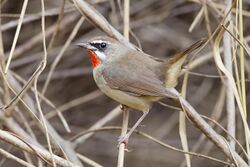Biology:Calliope (genus)
| Calliope | |
|---|---|

| |
| Male Siberian rubythroat (Calliope calliope) | |
| Scientific classification | |
| Domain: | Eukaryota |
| Kingdom: | Animalia |
| Phylum: | Chordata |
| Class: | Aves |
| Order: | Passeriformes |
| Family: | Muscicapidae |
| Subfamily: | Saxicolinae |
| Genus: | Calliope Gould, 1836 |
| Type species | |
| Calliope lathamii[1] Gould, 1836
| |
Calliope is a genus of passerine birds in the Old World flycatcher family Muscicapidae.
The species were previously placed in the genus Luscinia. A large molecular phylogenetic study published in 2010 found that Luscinia as defined in 2003 by Edward C. Dickinson was not monophyletic.[2][3] The genus Calliope, with the type species, Calliope calliope, was reinstated to accommodate a well-defined clade.[4][5] Although the blackthroat (Calliope obscura) had not been included in the 2010 phylogenetic analysis, a subsequent study found that the firethroat and the blackthroat were sister species and not colour morphs of the same species as some publications had previously suggested.[6]
The genus Calliope was introduced by the English ornithologist John Gould in 1836.[7][8] Calliope, from classical Greek meaning beautiful-voiced, was one of the muses in Greek mythology and presided over eloquence and heroic poetry.[9]
The genus contains the following five species:[4]
- Himalayan rubythroat (Calliope pectoralis)
- Chinese rubythroat (Calliope tschebaiewi) - formerly considered as a subspecies of the Himalayan rubythroat
- Siberian rubythroat (Calliope calliope)
- Firethroat (Calliope pectardens)
- Blackthroat (Calliope obscura)
References
- ↑ "Muscicapidae". The Trust for Avian Systematics. https://www.aviansystematics.org/4th-edition-checklist?viewfamilies=183.
- ↑ Dickinson, E.C., ed (2003). The Howard and Moore Complete Checklist of the Birds of the World (3rd ed.). London: Christopher Helm. ISBN 978-0-7136-6536-9.
- ↑ Sangster, G.; Alström, P.; Forsmark, E.; Olsson, U. (2010). "Multi-locus phylogenetic analysis of Old World chats and flycatchers reveals extensive paraphyly at family, subfamily and genus level (Aves: Muscicapidae)". Molecular Phylogenetics and Evolution 57 (1): 380–392. doi:10.1016/j.ympev.2010.07.008. PMID 20656044.
- ↑ 4.0 4.1 Gill, Frank; Donsker, David, eds (2016). "Chats, Old World flycatchers". World Bird List Version 6.2. International Ornithologists' Union. http://www.worldbirdnames.org/bow/chats/. Retrieved 20 May 2016.
- ↑ Dickinson, E.C.; Christidis, L., eds (2014). The Howard & Moore Complete Checklist of the Birds of the World. Volume 2, Passerines (4th ed.). Eastbourne, U.K.: Aves Press. ISBN 978-0-9568611-2-2.
- ↑ Alström, P.; Song, G.; Zhang, R.; Gao, X.; Holt, P.I.; Olsson, U.; Lei, F. (2013). "Taxonomic status of Blackthroat Calliope obscura and Firethroat C. pectardens". Forktail 29: 94–99. https://www.researchgate.net/publication/266141383.
- ↑ Gould, John (1836). The Birds of Europe. Volume 2. London: J. Gould. Plate 118. https://www.biodiversitylibrary.org/page/42173641. The title page has the year as 1837. Plate 118 has legend: Gorget Warbler, Calhope lathamii. The list of plates at the beginning of the volume has Calliope.
- ↑ Mayr, Ernst; Paynter, Raymond A. Jr. (1964). Check-list of Birds of the World. Volume 10. Cambridge, Massachusetts: Museum of Comparative Zoology. p. 33. https://www.biodiversitylibrary.org/page/14486222.
- ↑ Jobling, James A. (2010). The Helm Dictionary of Scientific Bird Names. London, United Kingdom: Christopher Helm. p. 85. ISBN 978-1-4081-2501-4. https://archive.org/details/Helm_Dictionary_of_Scientific_Bird_Names_by_James_A._Jobling.
Wikidata ☰ Q16069825 entry
 |

